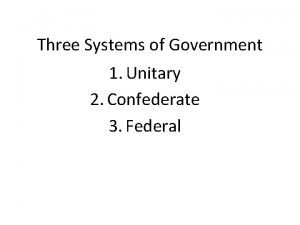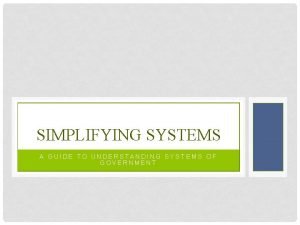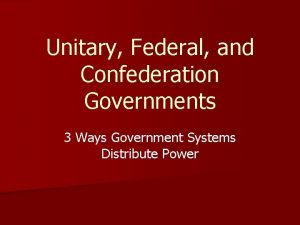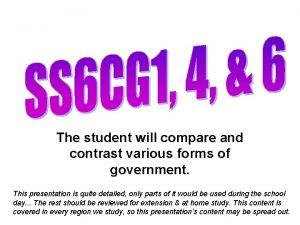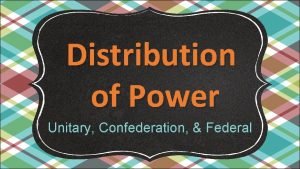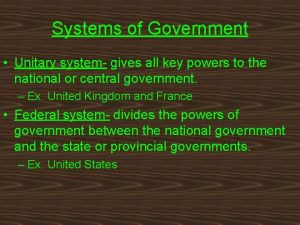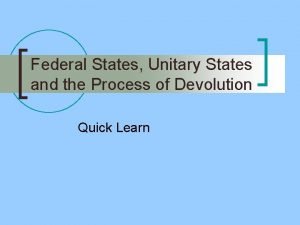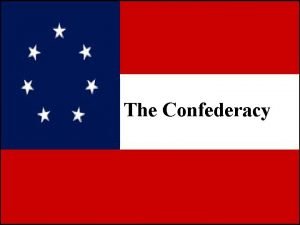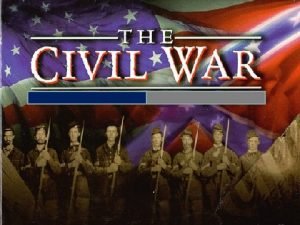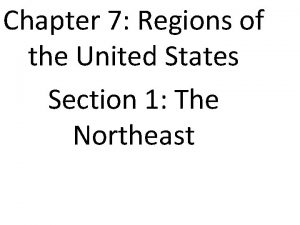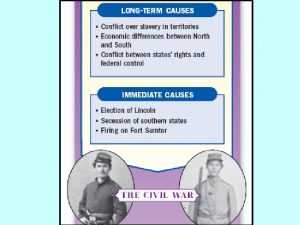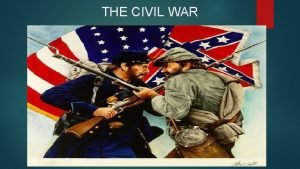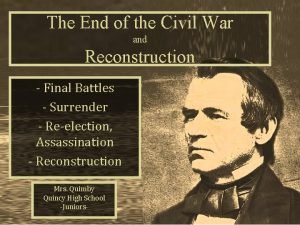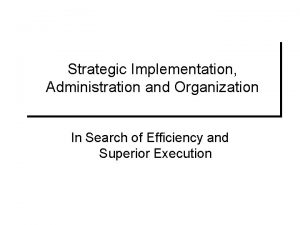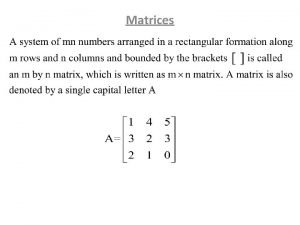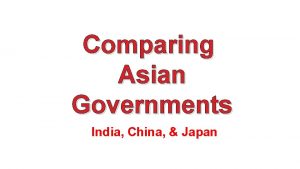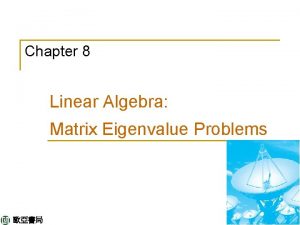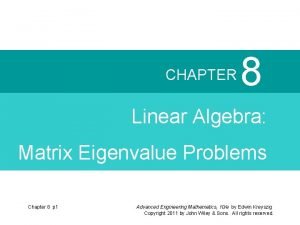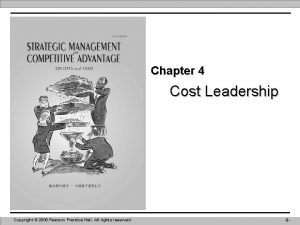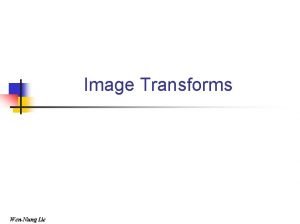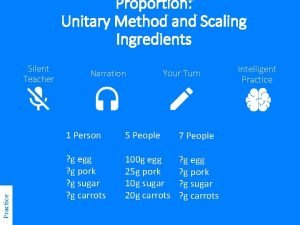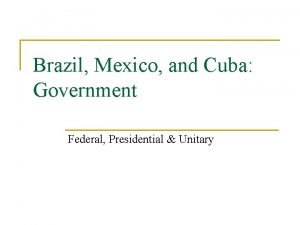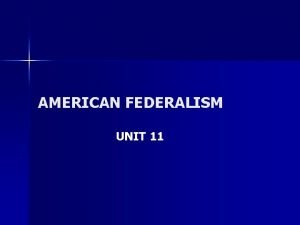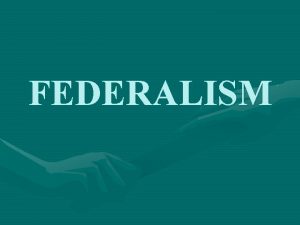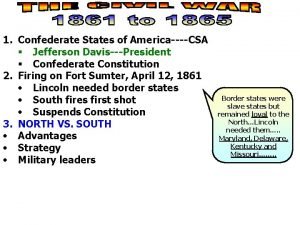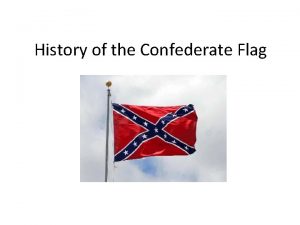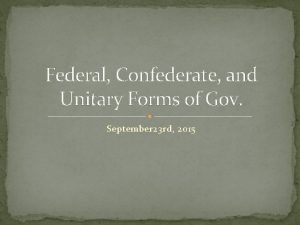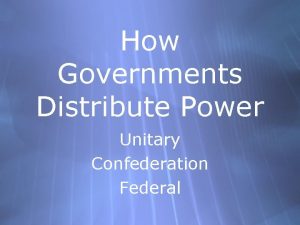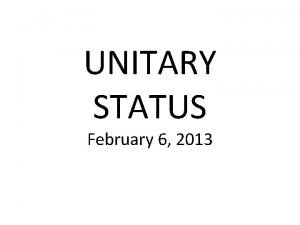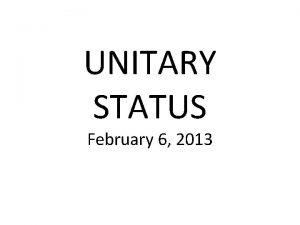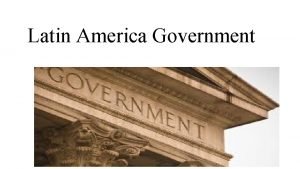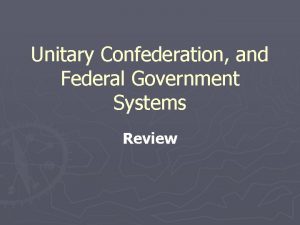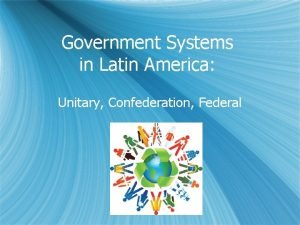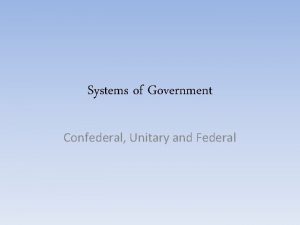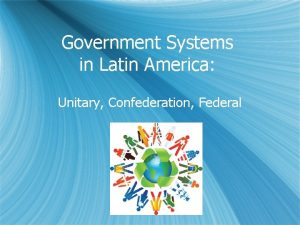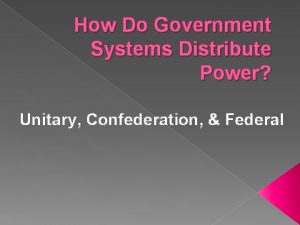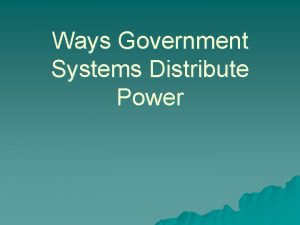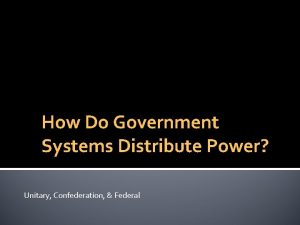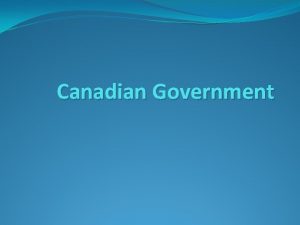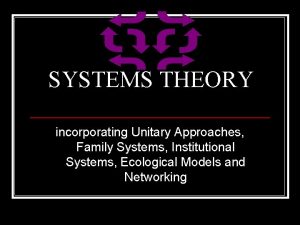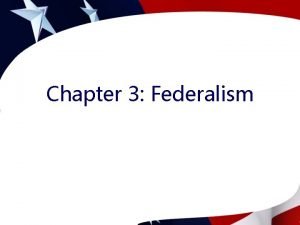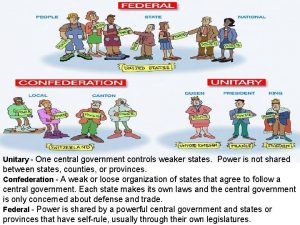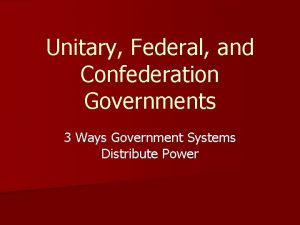Three Systems of Government 1 Unitary 2 Confederate


































- Slides: 34

Three Systems of Government 1. Unitary 2. Confederate 3. Federal


Unitary -System in which the national government creates sub national governments and gives them only the powers it wants them to have. -All power is vested in a central government. -Most nations in the world today have unitary governments, like Great Britain, France, and China

Confederate -System in which the central government has only those powers given to it by the sub national government. -Decentralized- weak central government has limited power over the states. -United States began as a confederation under the Articles of Confederation. “A League of Friendship”. The United Nations is a modern example.


Federalism -System in which power is divided by a written constitution between a central government and regional governments. -Examples: United States, Mexico, Canada, Germany, and India


Constitutional Division of Powers -Framers agreed that the confederate system under the Articles of Confederation was too weak for the new nation. -Framers ruled out a unitary system of government because the revolution had been fought against a distant central government in London. -Framers chose to balance order and freedom by creating a federal system that assigned powers to the national government while reserving other powers to the states.

Constitutional Division of Powers 1. Expressed powers/Enumerated powers/Delegated powers 2. Implied powers 3. Inherent powers 4. Reserved powers 5. Concurrent powers 6. Prohibited powers

Expressed powers/Enumerated powers/Delegated powers -These words all mean the same thing -Powers specifically granted to the federal government by the Constitution -Article 1, Section 8 lists 18 separate clauses that enumerate 27 specific powers to Congress (legislative branch) -Article II, Section 2 assigns the president several expressed powers (executive branch) -Article III grants “the judicial power of the United States” to the Supreme Court (judicial branch)

Expressed powers/Enumerated powers/Delegated powers -Several amendments contain expressed powers. The Sixteenth amendment gives Congress the power to levy an income tax. -Some key expressed powers include: 1. The power to regulate interstate and foreign commerce 2. The power to tax and spend 3. The war power

Implied powers -Not explicitly stated in the Constitution -Derived from Article 1, Section 8, Clause 18 - the necessary and proper clause!!! THIS CLAUSE IS A KEY PROVISION which gives Congress the power “to make all laws which shall be necessary and proper for carrying into Execution the forgoing Powers and all other Powers vested by the Constitution in the Government of the US or in any Department or Officer thereof. “

Implied powers -The necessary and proper clause enables the national government to meet problems the Framers could not anticipate. -It insured the growth of national power by enabling the federal government to extend its powers beyond those enumerated in the Constitution.

Implied powers. Mc. Cullough v Maryland (1819) -In 1816 Congress chartered the Second National Bank of the United States. -In 1818, the Maryland legislature passed a law imposing a substantial tax on the operation of the Baltimore branch of the bank. -James Mc. Culloch, cashier of the Baltimore branch, refused to pay the tax. -When the Maryland state courts told him to pay up (aka they ruled against him), Mc. Cullough appealed to the US Supreme Court.

Implied powers. Mc. Cullough v Maryland (1819) Constitutional Questions the Supreme Court had to consider: 1. Does the Constitution permit Congress to charter a bank? 2. Does a state have a constitutional right to tax an agency of the US government?

Implied powers. Mc. Cullough v. Maryland (1819) The Court’s decision -Supreme Court ruled that creating a national bank was within the implied powers of Congress -The Constitution does specifically grant Congress the power to impose taxes, issue a currency, and borrow money. -The Constitution does not specifically enumerate creating a bank, it does grant Congress the power to “make all laws necessary and proper for carrying into execution the foregoing powers. ” Congress may thus reasonably decide that chartering a national bank is a “necessary and proper” way to carry out its expressed powers.

Implied powers. Mc. Cullough v. Maryland (1819) The Court’s decision -The Court also held that the Maryland law was unconstitutional because it violated the principle of the supremacy of the national government over the states. - The case confirmed the right of Congress to utilize implied powers to carry out its expressed powers. -The decision validated the supremacy of the national government over the states by declaring that states cannot interfere with or tax the legitimate activities of the federal government.

Inherent powers -Inherent powers derive from the fact that the United States is a sovereign nation. - Under international law, all nation-states have the right to make treaties, wage war, and acquire territory.

Reserved powers -Reserved powers are held solely by the states. -The Tenth Amendment states “The powers not delegated to the United States by the Constitution, nor prohibited by it to the states, are reserved to the states respectively, or to the people. ” -Reserved powers include licensing doctors, establishing public schools, and establishing local governments. They also include the police powerthe authority of a state to protect and promote the public morals, health, safety, and general welfare.

Reserved powers -Reserved powers are held solely by the states. -The Tenth Amendment states “The powers not delegated to the United States by the Constitution, nor prohibited by it to the states, are reserved to the states respectively, or to the people. ” -Reserved powers include licensing doctors, establishing public schools, and establishing local governments. They also include the police powerthe authority of a state to protect and promote the public morals, health, safety, and general welfare.

Concurrent powers -Powers exercised by both national and state governments. -Include the power to tax, borrow money, and establish courts.

Prohibited powers -Powers denied to the national government, state governments, or both. -For example, the federal government cannot tax exports, and states cannot make treaties with foreign countries.

Interstate relations -Article IV of addresses the issue of the relationships between the states. -full faith and credit clause: States are required to recognize the laws and legal documents of other states, such as birth certificates, marriage licenses, drivers' licenses, wills.

The Commerce Clause Gibbons v. Ogden (1824) -Forbade states from enacting any legislation that would interfere with Congress’ right to regulate commerce among the separate states. -The Supreme Court defined commerce as all commercial business dealings. As such, commerce includes the production, buying, selling, renting, and transporting of goods, services, and properties. -Congress regulates all interstate commerce. -The Supreme Court’s broad definition of commerce enabled Congress to promote economic growth by supporting the construction of roads, canals, and railroad lines.

The Commerce Clause -The commerce clause has played a key role in the expansion of federal power. -The national government now regulates a wide variety of commercial activities, including radio signals, telephone messages, and financial transactions. -The commerce clause and the necessary and proper clause have been used to increase the power of the federal government relative to the power of state governments.

The power to regulate interstate commerce allowed Congress to forbid discrimination like this in places of public accommodation in the 1964 Civil Rights Act.

Kinds of federalism Dual federalism(1789 -1932) “Layer cake federalism” -The earliest interpretation of federalism -Views the national and state governments each remaining supreme within their own sphere of influence. -Each level of government is seen as separate from the other. -Example of dual federalism: 1. The early belief that states had the sole responsibility for educating their citizens.

Kinds of federalism Cooperative federalism (1930 s-1970 s) “Marble cake federalism” -In the 1930 s the interpretation of federalism shifted to that of the national and state governments sharing policymaking and cooperating in solving problems. -Grew from the policies of the New Deal era and the need for the national government to increase government spending and public assistance programs during the Great Depression. -The cooperation of the national and state governments to build the national interstate highway system is an example of cooperative federalism. -


Kinds of federalism New federalism (1970 s-1990 s) -A reversal of cooperative federalism -Places more responsibility on the states about how grant money would be spent. -Devolution has been used to describe the goals of new federalism -Devolution- reassignment of policy making or implementation of powers from higher levels of government to lower levels of government. -An example of new federalism is welfare reform legislation, which has returned more authority over welfare programs to the states.

Kinds of federalism Fiscal federalism -The national government's patterns of spending, taxation, and providing grants to influence state and local governments is known today as fiscal federalism. -The national government uses fiscal policy to influence the states through granting or withholding money to pay for programs.

Advantages of Federalism -Ideally suited to large geographic area because it encourages diversity in local government -Avoids concentration of political power -Accommodated already existing state governments -States serve as training grounds for national leaders -Keeps government close to the people

Disadvantages of Federalism -Inflexibility inherent in a written constitution -Complex, with many governments to deal with -Duplication of offices and functions -Conflicts of authority may arise

 Government
Government Confederal system diagram
Confederal system diagram What is a unitary system of government
What is a unitary system of government Unitary government diagram
Unitary government diagram Parliamentary system vs presidential system
Parliamentary system vs presidential system How is power distributed in a unitary government
How is power distributed in a unitary government A unitary system of government gives all key powers to the
A unitary system of government gives all key powers to the Unitary systems
Unitary systems Confederate advantages
Confederate advantages Union vs confederate
Union vs confederate Confederate advantages
Confederate advantages Advantages and disadvantages of the north and south
Advantages and disadvantages of the north and south Yosemite sam confederate
Yosemite sam confederate Union and confederate advantages chart
Union and confederate advantages chart Vus 7b when did the civil war officially begin?
Vus 7b when did the civil war officially begin? Reconstruction
Reconstruction Confederate states of america
Confederate states of america Unitary form organizational structure
Unitary form organizational structure Orthogonal matrix example 3x3
Orthogonal matrix example 3x3 Unitary elastic
Unitary elastic Price elasticity of supply formula
Price elasticity of supply formula Comparing asian governments
Comparing asian governments 3x3 orthogonal matrix
3x3 orthogonal matrix Orthogonal transformation
Orthogonal transformation Unitary form organizational structure
Unitary form organizational structure Unitary form organizational structure
Unitary form organizational structure Unitary method
Unitary method Martha rogers theory of unitary human beings pdf
Martha rogers theory of unitary human beings pdf Orthogonal transformation in image processing
Orthogonal transformation in image processing Unitary elastic demand
Unitary elastic demand Unitary actor realism
Unitary actor realism Unitary method
Unitary method Cuba
Cuba Power in politics definition
Power in politics definition Unitary definition
Unitary definition
